- GCN/BACODINE POSITION NOTICE
TITLE: GCN/SWIFT NOTICE
NOTICE_DATE: Sun 22 Apr 12 07:12:49 UT
NOTICE_TYPE: Swift-BAT GRB Position
TRIGGER_NUM: 520658, Seg_Num: 0
GRB_RA: 136.929d {+09h 07m 43s} (J2000),
137.098d {+09h 08m 24s} (current),
136.240d {+09h 04m 58s} (1950)
GRB_DEC: +14.006d {+14d 00' 23"} (J2000),
+13.956d {+13d 57' 23"} (current),
+14.209d {+14d 12' 31"} (1950)
GRB_ERROR: 3.00 [arcmin radius, statistical only]
GRB_INTEN: 14754 [cnts] Image_Peak=380 [image_cnts]
TRIGGER_DUR: 4.096 [sec]
TRIGGER_INDEX: 298 E_range: 25-100 keV
BKG_INTEN: 128240 [cnts]
BKG_TIME: 25863.87 SOD {07:11:03.87} UT
BKG_DUR: 40 [sec]
GRB_DATE: 16039 TJD; 113 DOY; 12/04/22
GRB_TIME: 25923.64 SOD {07:12:03.64} UT
GRB_PHI: -110.99 [deg]
GRB_THETA: 23.54 [deg]
SOLN_STATUS: 0x3
RATE_SIGNIF: 11.83 [sigma]
IMAGE_SIGNIF: 8.33 [sigma]
MERIT_PARAMS: +1 +0 +0 +2 +2 -1 +0 +0 +22 +0
SUN_POSTN: 30.37d {+02h 01m 28s} +12.36d {+12d 21' 40"}
SUN_DIST: 102.78 [deg] Sun_angle= -7.1 [hr] (East of Sun)
MOON_POSTN: 40.22d {+02h 40m 53s} +17.64d {+17d 38' 26"}
MOON_DIST: 92.16 [deg]
MOON_ILLUM: 1 [%]
GAL_COORDS: 215.24, 36.45 [deg] galactic lon,lat of the burst (or transient)
ECL_COORDS: 135.19, -2.38 [deg] ecliptic lon,lat of the burst (or transient)
COMMENTS: SWIFT-BAT GRB Coordinates.
COMMENTS: This is a rate trigger.
COMMENTS: A point_source was found.
COMMENTS: This does not match any source in the on-board catalog.
COMMENTS: This does not match any source in the ground catalog.
COMMENTS: This is a GRB.
COMMENTS: This trigger occurred at longitude,latitude = 180.72,-19.45 [deg].
- red DSS finding chart
ps-file
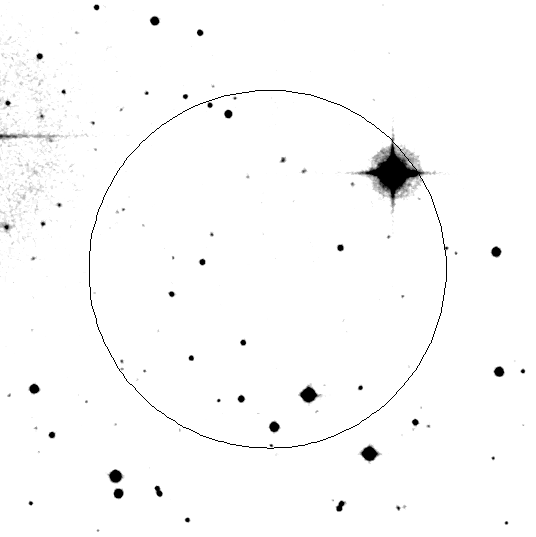
- GCN NOTICE
TITLE: GCN/SWIFT NOTICE
NOTICE_DATE: Sun 22 Apr 12 07:14:15 UT
NOTICE_TYPE: Swift-XRT Position
TRIGGER_NUM: 520658, Seg_Num: 0
GRB_RA: 136.9122d {+09h 07m 38.92s} (J2000),
137.0815d {+09h 08m 19.56s} (current),
136.2235d {+09h 04m 53.64s} (1950)
GRB_DEC: +14.0183d {+14d 01' 05.8"} (J2000),
+13.9682d {+13d 58' 05.5"} (current),
+14.2205d {+14d 13' 13.7"} (1950)
GRB_ERROR: 5.0 [arcsec radius, statistical plus systematic, 90% containment]
GRB_INTEN: 3.12e-09 [erg/cm2/sec]
GRB_SIGNIF: 10.81 [sigma]
IMG_START_DATE: 16039 TJD; 113 DOY; 12/04/22
IMG_START_TIME: 26018.71 SOD {07:13:38.71} UT, 95.1 [sec] since BAT Trigger Time
TAM[0-3]: 327.65 237.21 261.52 243.67
AMPLIFIER: 2
WAVEFORM: 134
SUN_POSTN: 30.37d {+02h 01m 28s} +12.36d {+12d 21' 41"}
SUN_DIST: 102.77 [deg] Sun_angle= -7.1 [hr] (East of Sun)
MOON_POSTN: 40.23d {+02h 40m 56s} +17.64d {+17d 38' 36"}
MOON_DIST: 92.13 [deg]
MOON_ILLUM: 1 [%]
GAL_COORDS: 215.22, 36.44 [deg] galactic lon,lat of the burst
ECL_COORDS: 135.17, -2.37 [deg] ecliptic lon,lat of the burst
COMMENTS: SWIFT-XRT Coordinates.
COMMENTS: The XRT position is 1.21 arcmin from the BAT position.
- GCN NOTICE
TITLE: GCN/SWIFT NOTICE
NOTICE_DATE: Sun 22 Apr 12 07:14:25 UT
NOTICE_TYPE: Swift-XRT Image
TRIGGER_NUM: 520658, Seg_Num: 0
GRB_RA: 136.9122d {+09h 07m 38.9s} (J2000),
137.0815d {+09h 08m 19.5s} (current),
136.2235d {+09h 04m 53.6s} (1950)
GRB_DEC: +14.0183d {+14d 01' 05.8"} (J2000),
+13.9682d {+13d 58' 05.5"} (current),
+14.2205d {+14d 13' 13.7"} (1950)
GRB_ERROR: 4.7 [arcsec, radius, statistical plus systematic]
GRB_INTEN: 117 [cnts]
IMG_START_DATE: 16039 TJD; 113 DOY; 12/04/22
IMG_START_TIME: 26018.71 SOD {07:13:38.71} UT, 95.1 [sec] since BAT Trigger Time
CENTROID_X: 250.53, raw= 251 [pixels]
CENTROID_Y: 298.07, raw= 298 [pixels]
ROLL: 286.40 [deg]
GAIN: 1
MODE: 3, Long Image mode
WAVEFORM: 134
EXPO_TIME: 2.50 [sec]
GRB_POS_XRT_Y: 0.18
GRB_POS_XRT_Z: -125.32
IMAGE_URL: sw00520658000msxps_rw.img
SUN_POSTN: 30.37d {+02h 01m 28s} +12.36d {+12d 21' 41"}
SUN_DIST: 102.76 [deg] Sun_angle= -7.1 [hr] (East of Sun)
MOON_POSTN: 40.24d {+02h 40m 56s} +17.64d {+17d 38' 37"}
MOON_DIST: 92.12 [deg]
MOON_ILLUM: 1 [%]
GAL_COORDS: 215.22, 36.44 [deg] galactic lon,lat of the burst
ECL_COORDS: 135.17, -2.37 [deg] ecliptic lon,lat of the burst
COMMENTS: SWIFT-XRT Image.

- GCN NOTICE
TITLE: GCN/SWIFT NOTICE
NOTICE_DATE: Sun 22 Apr 12 07:14:33 UT
NOTICE_TYPE: Swift-XRT Processed Image
TRIGGER_NUM: 520658, Seg_Num: 0
GRB_RA: 136.9122d {+09h 07m 38.9s} (J2000),
137.0815d {+09h 08m 19.5s} (current),
136.2235d {+09h 04m 53.6s} (1950)
GRB_DEC: +14.0183d {+14d 01' 05.8"} (J2000),
+13.9682d {+13d 58' 05.5"} (current),
+14.2205d {+14d 13' 13.7"} (1950)
GRB_ERROR: 4.7 [arcsec, radius, statistical plus systematic]
GRB_INTEN: 117 [cnts]
IMG_START_DATE: 16039 TJD; 113 DOY; 12/04/22
IMG_START_TIME: 26018.71 SOD {07:13:38.71} UT, 95.1 [sec] since BAT Trigger Time
CENTROID_X: 250.53, raw= 251 [pixels]
CENTROID_Y: 298.07, raw= 298 [pixels]
ROLL: 286.40 [deg]
GAIN: 1
MODE: 3, Long Image mode
WAVEFORM: 134
EXPO_TIME: 2.50 [sec]
GRB_POS_XRT_Y: 0.18
GRB_POS_XRT_Z: -125.32
IMAGE_URL: sw00520658000msxps_rw.img
SUN_POSTN: 30.37d {+02h 01m 28s} +12.36d {+12d 21' 41"}
SUN_DIST: 102.76 [deg] Sun_angle= -7.1 [hr] (East of Sun)
MOON_POSTN: 40.24d {+02h 40m 57s} +17.64d {+17d 38' 38"}
MOON_DIST: 92.12 [deg]
MOON_ILLUM: 1 [%]
GAL_COORDS: 215.22, 36.44 [deg] galactic lon,lat of the burst
ECL_COORDS: 135.17, -2.37 [deg] ecliptic lon,lat of the burst
COMMENTS: SWIFT-XRT Processed Image.

- GCN NOTICE
TITLE: GCN/SWIFT NOTICE
NOTICE_DATE: Sun 22 Apr 12 07:15:43 UT
NOTICE_TYPE: Swift-BAT GRB Lightcurve
TRIGGER_NUM: 520658, Seg_Num: 0
GRB_RA: 136.929d {+09h 07m 43s} (J2000),
137.098d {+09h 08m 24s} (current),
136.240d {+09h 04m 58s} (1950)
GRB_DEC: +14.006d {+14d 00' 23"} (J2000),
+13.956d {+13d 57' 23"} (current),
+14.209d {+14d 12' 31"} (1950)
GRB_DATE: 16039 TJD; 113 DOY; 12/04/22
GRB_TIME: 25923.64 SOD {07:12:03.64} UT
TRIGGER_INDEX: 298
GRB_PHI: -110.99 [deg]
GRB_THETA: 23.54 [deg]
DELTA_TIME: -56.00 [sec]
TRIGGER_DUR: 4.096 [sec]
SOLN_STATUS: 0x3
RATE_SIGNIF: 11.83 [sigma]
IMAGE_SIGNIF: 8.33 [sigma]
LC_URL: sw00520658000msb.lc
SUN_POSTN: 30.37d {+02h 01m 28s} +12.36d {+12d 21' 42"}
SUN_DIST: 102.78 [deg] Sun_angle= -7.1 [hr] (East of Sun)
MOON_POSTN: 40.25d {+02h 40m 59s} +17.65d {+17d 38' 46"}
MOON_DIST: 92.13 [deg]
MOON_ILLUM: 1 [%]
GAL_COORDS: 215.24, 36.45 [deg] galactic lon,lat of the burst (or transient)
ECL_COORDS: 135.19, -2.38 [deg] ecliptic lon,lat of the burst (or transient)
COMMENTS: SWIFT-BAT GRB Lightcurve.
COMMENTS:
COMMENTS: The next comments were copied from the BAT_POS Notice:
COMMENTS: This is a rate trigger.
COMMENTS: A point_source was found.
COMMENTS: This does not match any source in the on-board catalog.
COMMENTS: This does not match any source in the ground catalog.
COMMENTS: This is a GRB.
COMMENTS: This trigger occurred at longitude,latitude = 180.72,-19.45 [deg].

- GCN NOTICE
TITLE: GCN/SWIFT NOTICE
NOTICE_DATE: Sun 22 Apr 12 07:16:52 UT
NOTICE_TYPE: Swift-UVOT Source List
TRIGGER_NUM: 520658, Seg_Num: 0
POINT_RA: 136.946d {+09h 07m 47s} (J2000)
POINT_DEC: +14.008d {+14d 00' 29"} (J2000)
POINT_ROLL: 286.396d
IMG_START_DATE: 16039 TJD; 113 DOY; 12/04/22
IMG_START_TIME: 26028.13 SOD {07:13:48.13} UT, 104.5 [sec] since BAT Trigger Time
FILTER: 10, White
BKG_MEAN: 2.878
N_STARS: 92
X_OFFSET: 568 [pixels]
Y_OFFSET: 440 [pixels]
X_MAX: 1527 [pixels]
Y_MAX: 1399 [pixels]
DET_THRESH: 14
PHOTO_THRESH: 7
SL_URL: sw00520658000msufc0104.fits
SUN_POSTN: 30.37d {+02h 01m 29s} +12.36d {+12d 21' 43"}
SUN_DIST: 102.80 [deg] Sun_angle= -7.1 [hr] (East of Sun)
MOON_POSTN: 40.26d {+02h 41m 01s} +17.65d {+17d 38' 53"}
MOON_DIST: 92.14 [deg]
MOON_ILLUM: 1 [%]
GAL_COORDS: 215.25, 36.47 [deg] galactic lon,lat of the pointing direction
ECL_COORDS: 135.20, -2.37 [deg] ecliptic lon,lat of the pointing direction
COMMENTS: SWIFT-UVOT Source List.
- GCN NOTICE
TITLE: GCN/SWIFT NOTICE
NOTICE_DATE: Sun 22 Apr 12 07:17:19 UT
NOTICE_TYPE: Swift-UVOT Processed Source List
TRIGGER_NUM: 520658, Seg_Num: 0
POINT_RA: 136.946d {+09h 07m 47s} (J2000)
POINT_DEC: +14.008d {+14d 00' 29"} (J2000)
POINT_ROLL: 286.396d
IMG_START_DATE: 16039 TJD; 113 DOY; 12/04/22
IMG_START_TIME: 26028.13 SOD {07:13:48.13} UT, 104.5 [sec] since BAT Trigger Time
FILTER: 10, White
BKG_MEAN: 2.878
N_STARS: 92
X_OFFSET: 568 [pixels]
Y_OFFSET: 440 [pixels]
X_MAX: 1527 [pixels]
Y_MAX: 1399 [pixels]
DET_THRESH: 14
PHOTO_THRESH: 7
SL_URL: sw00520658000msufc0104.fits
SUN_POSTN: 30.37d {+02h 01m 29s} +12.36d {+12d 21' 44"}
SUN_DIST: 102.80 [deg] Sun_angle= -7.1 [hr] (East of Sun)
MOON_POSTN: 40.26d {+02h 41m 02s} +17.65d {+17d 38' 56"}
MOON_DIST: 92.14 [deg]
MOON_ILLUM: 1 [%]
GAL_COORDS: 215.25, 36.47 [deg] galactic lon,lat of the pointing direction
ECL_COORDS: 135.20, -2.37 [deg] ecliptic lon,lat of the pointing direction
COMMENTS: SWIFT-UVOT Processed Source List.
COMMENTS: All 4 attachments are included.
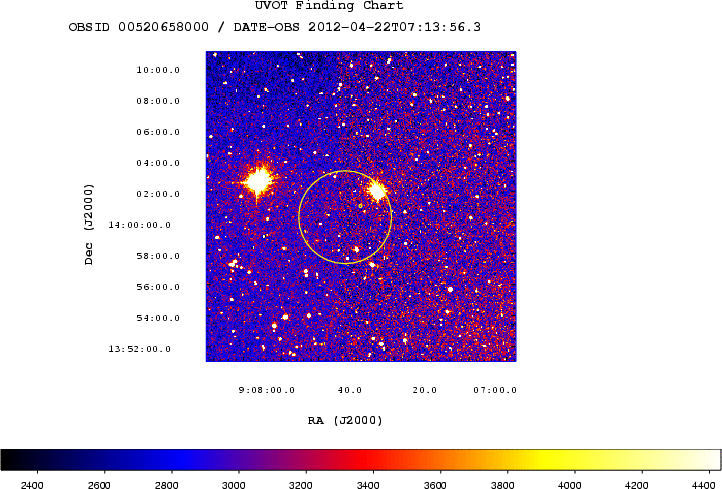
- GCN NOTICE
TITLE: GCN/SWIFT NOTICE
NOTICE_DATE: Sun 22 Apr 12 07:18:42 UT
NOTICE_TYPE: Swift-UVOT Image
TRIGGER_NUM: 520658, Seg_Num: 0
POINT_RA: 136.946d {+09h 07m 47s} (J2000)
POINT_DEC: +14.008d {+14d 00' 29"} (J2000)
ROLL: 286.396d
IMG_START_DATE: 16039 TJD; 113 DOY; 12/04/22
IMG_START_TIME: 26028.13 SOD {07:13:48.13} UT, 104.5 [sec] since BAT Trigger Time
FILTER: 10, White
EXPOSURE_ID: 356771636
X_OFFSET: 1026 [pixels]
Y_OFFSET: 740 [pixels]
WIDTH: 160 [pixels]
HEIGHT: 160 [pixels]
X_GRB_POS: 1186
Y_GRB_POS: 900
BINNING_INDEX: 1
IM_URL: sw00520658000msuni0113.fits
SUN_POSTN: 30.37d {+02h 01m 29s} +12.36d {+12d 21' 45"}
SUN_DIST: 102.80 [deg] Sun_angle= -7.1 [hr] (East of Sun)
MOON_POSTN: 40.27d {+02h 41m 05s} +17.65d {+17d 39' 05"}
MOON_DIST: 92.12 [deg]
MOON_ILLUM: 1 [%]
GAL_COORDS: 215.25, 36.47 [deg] galactic lon,lat of the pointing direction
ECL_COORDS: 135.20, -2.37 [deg] ecliptic lon,lat of the pointing direction
COMMENTS: SWIFT-UVOT Image.
COMMENTS: The GRB Position came from the XRT Position Command.
COMMENTS: The image has 2x2 binning (compression).
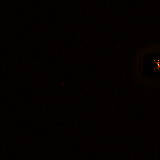
- GCN NOTICE
TITLE: GCN/SWIFT NOTICE
NOTICE_DATE: Sun 22 Apr 12 07:18:52 UT
NOTICE_TYPE: Swift-UVOT Processed Image
TRIGGER_NUM: 520658, Seg_Num: 0
POINT_RA: 136.946d {+09h 07m 47s} (J2000)
POINT_DEC: +14.008d {+14d 00' 29"} (J2000)
ROLL: 286.396d
IMG_START_DATE: 16039 TJD; 113 DOY; 12/04/22
IMG_START_TIME: 26028.13 SOD {07:13:48.13} UT, 104.5 [sec] since BAT Trigger Time
FILTER: 10, White
EXPOSURE_ID: 356771636
X_OFFSET: 1026 [pixels]
Y_OFFSET: 740 [pixels]
WIDTH: 160 [pixels]
HEIGHT: 160 [pixels]
X_GRB_POS: 1186
Y_GRB_POS: 900
BINNING_INDEX: 1
IM_URL: sw00520658000msuni0113.fits
SUN_POSTN: 30.37d {+02h 01m 29s} +12.36d {+12d 21' 45"}
SUN_DIST: 102.80 [deg] Sun_angle= -7.1 [hr] (East of Sun)
MOON_POSTN: 40.27d {+02h 41m 05s} +17.65d {+17d 39' 06"}
MOON_DIST: 92.12 [deg]
MOON_ILLUM: 1 [%]
GAL_COORDS: 215.25, 36.47 [deg] galactic lon,lat of the pointing direction
ECL_COORDS: 135.20, -2.37 [deg] ecliptic lon,lat of the pointing direction
COMMENTS: SWIFT-UVOT Processed Image.
COMMENTS: The GRB Position came from the XRT Position Command.
COMMENTS: The image has 2x2 binning (compression).
COMMENTS: All 4 attachments are included.
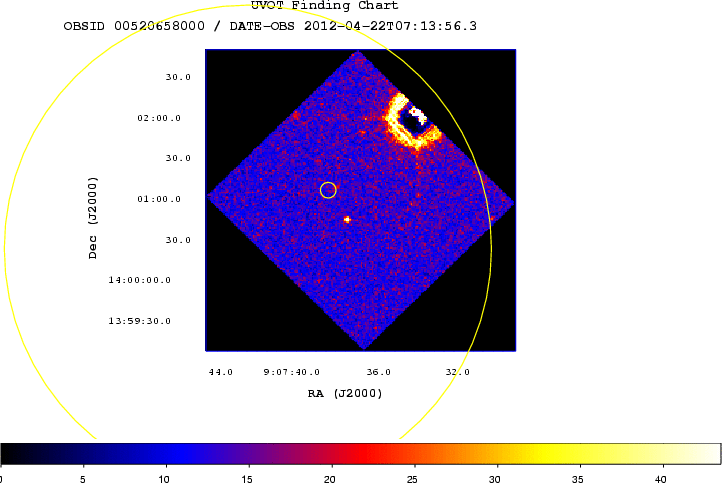
- GCN Circular #13243
E. Troja (NASA/GSFC/ORAU), V. D'Elia (ASDC), C. Guidorzi (U Ferrara),
E. A. Hoversten (PSU), H. A. Krimm (CRESST/GSFC/USRA),
A. Y. Lien (NASA/GSFC/ORAU), O. M. Littlejohns (U Leicester),
A. Melandri (INAF-OAB), K. L. Page (U Leicester) and
D. M. Palmer (LANL) report on behalf of the Swift Team:
At 07:12:03 UT, the Swift Burst Alert Telescope (BAT) triggered and
located GRB 120422A (trigger=520658). Swift slewed immediately to the burst.
The BAT on-board calculated location is
RA, Dec 136.929, +14.006 which is
RA(J2000) = 09h 07m 43s
Dec(J2000) = +14d 00' 23"
with an uncertainty of 3 arcmin (radius, 90% containment, including
systematic uncertainty). The BAT light curve showed a single complex peak
structure with a duration of about 10 sec. The peak count rate
was ~800 counts/sec (15-350 keV), at ~0 sec after the trigger.
The XRT began observing the field at 07:13:38.7 UT, 95.1 seconds after
the BAT trigger. Using promptly downlinked data we find a bright,
uncatalogued X-ray source located at RA, Dec 136.91183, 14.01873 which
is equivalent to:
RA(J2000) = 09h 07m 38.84s
Dec(J2000) = +14d 01' 07.4"
with an uncertainty of 4.2 arcseconds (radius, 90% containment). This
location is 75 arcseconds from the BAT onboard position, within the BAT
error circle. This position may be improved as more data are received;
the latest position is available at http://www.swift.ac.uk/sper. We
cannot determine whether the source is fading at the present time.
A power-law fit to a spectrum formed from promptly downlinked event
data gives a column density consistent with the Galactic value of 3.71
x 10^20 cm^-2 (Kalberla et al. 2005).
The initial flux in the 2.5 s image was 3.12e-09 erg cm^-2 s^-1 (0.2-10
keV).
UVOT took a finding chart exposure of 150 seconds with the White filter
starting 104 seconds after the BAT trigger. No credible afterglow candidate has
been found in the initial data products. The 2.7'x2.7' sub-image covers 100% of
the XRT error circle. The typical 3-sigma upper limit has been about 19.6 mag.
The 8'x8' region for the list of sources generated on-board covers 100% of the
XRT error circle. The list of sources is typically complete to about 18 mag. No
correction has been made for the expected extinction corresponding to E(B-V) of
0.03.
Burst Advocate for this burst is E. Troja (eleonora.troja AT nasa.gov).
Please contact the BA by email if you require additional information
regarding Swift followup of this burst. In extremely urgent cases, after
trying the Burst Advocate, you can contact the Swift PI by phone (see
Swift TOO web site for information: http://www.swift.psu.edu/too.html.)
- GCN NOTICE
TITLE: GCN/SWIFT NOTICE
NOTICE_DATE: Sun 22 Apr 12 07:24:59 UT
NOTICE_TYPE: Swift-UVOT Source List
TRIGGER_NUM: 520658, Seg_Num: 0
POINT_RA: 136.949d {+09h 07m 48s} (J2000)
POINT_DEC: +14.009d {+14d 00' 32"} (J2000)
POINT_ROLL: 286.398d
IMG_START_DATE: 16039 TJD; 113 DOY; 12/04/22
IMG_START_TIME: 26185.98 SOD {07:16:25.98} UT, 262.3 [sec] since BAT Trigger Time
FILTER: 7, U
BKG_MEAN: 0.848
N_STARS: 33
X_OFFSET: 706 [pixels]
Y_OFFSET: 420 [pixels]
X_MAX: 1665 [pixels]
Y_MAX: 1379 [pixels]
DET_THRESH: 8
PHOTO_THRESH: 4
SL_URL: sw00520658000msufc0262.fits
SUN_POSTN: 30.37d {+02h 01m 30s} +12.36d {+12d 21' 50"}
SUN_DIST: 102.79 [deg] Sun_angle= -7.1 [hr] (East of Sun)
MOON_POSTN: 40.32d {+02h 41m 18s} +17.66d {+17d 39' 47"}
MOON_DIST: 92.07 [deg]
MOON_ILLUM: 1 [%]
GAL_COORDS: 215.25, 36.47 [deg] galactic lon,lat of the pointing direction
ECL_COORDS: 135.20, -2.37 [deg] ecliptic lon,lat of the pointing direction
COMMENTS: SWIFT-UVOT Source List.
- GCN NOTICE
TITLE: GCN/SWIFT NOTICE
NOTICE_DATE: Sun 22 Apr 12 07:25:15 UT
NOTICE_TYPE: Swift-UVOT Processed Source List
TRIGGER_NUM: 520658, Seg_Num: 0
POINT_RA: 136.949d {+09h 07m 48s} (J2000)
POINT_DEC: +14.009d {+14d 00' 32"} (J2000)
POINT_ROLL: 286.398d
IMG_START_DATE: 16039 TJD; 113 DOY; 12/04/22
IMG_START_TIME: 26185.98 SOD {07:16:25.98} UT, 262.3 [sec] since BAT Trigger Time
FILTER: 7, U
BKG_MEAN: 0.848
N_STARS: 33
X_OFFSET: 706 [pixels]
Y_OFFSET: 420 [pixels]
X_MAX: 1665 [pixels]
Y_MAX: 1379 [pixels]
DET_THRESH: 8
PHOTO_THRESH: 4
SL_URL: sw00520658000msufc0262.fits
SUN_POSTN: 30.37d {+02h 01m 30s} +12.36d {+12d 21' 50"}
SUN_DIST: 102.79 [deg] Sun_angle= -7.1 [hr] (East of Sun)
MOON_POSTN: 40.33d {+02h 41m 18s} +17.66d {+17d 39' 49"}
MOON_DIST: 92.07 [deg]
MOON_ILLUM: 1 [%]
GAL_COORDS: 215.25, 36.47 [deg] galactic lon,lat of the pointing direction
ECL_COORDS: 135.20, -2.37 [deg] ecliptic lon,lat of the pointing direction
COMMENTS: SWIFT-UVOT Processed Source List.
COMMENTS: All 4 attachments are included.
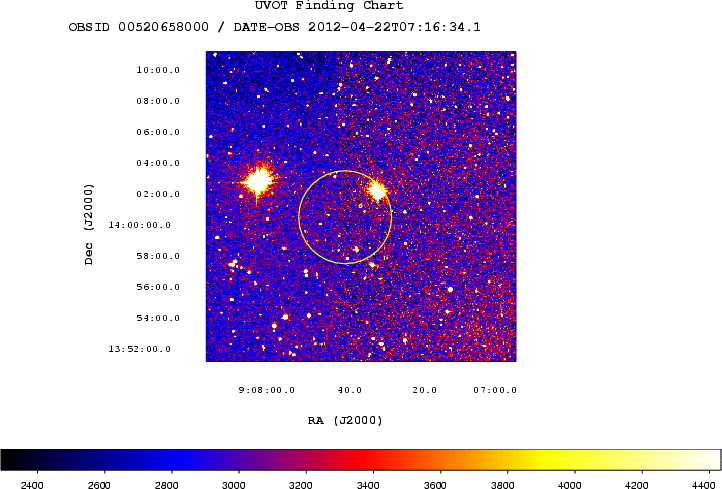
- GCN NOTICE
TITLE: GCN/SWIFT NOTICE
NOTICE_DATE: Sun 22 Apr 12 07:26:35 UT
NOTICE_TYPE: Swift-UVOT Image
TRIGGER_NUM: 520658, Seg_Num: 0
POINT_RA: 136.949d {+09h 07m 48s} (J2000)
POINT_DEC: +14.009d {+14d 00' 32"} (J2000)
ROLL: 286.398d
IMG_START_DATE: 16039 TJD; 113 DOY; 12/04/22
IMG_START_TIME: 26185.98 SOD {07:16:25.98} UT, 262.3 [sec] since BAT Trigger Time
FILTER: 7, U
EXPOSURE_ID: 356771794
X_OFFSET: 1026 [pixels]
Y_OFFSET: 740 [pixels]
WIDTH: 160 [pixels]
HEIGHT: 160 [pixels]
X_GRB_POS: 1186
Y_GRB_POS: 900
BINNING_INDEX: 1
IM_URL: sw00520658000msuni0271.fits
SUN_POSTN: 30.38d {+02h 01m 30s} +12.36d {+12d 21' 51"}
SUN_DIST: 102.79 [deg] Sun_angle= -7.1 [hr] (East of Sun)
MOON_POSTN: 40.34d {+02h 41m 21s} +17.67d {+17d 39' 57"}
MOON_DIST: 92.06 [deg]
MOON_ILLUM: 1 [%]
GAL_COORDS: 215.25, 36.47 [deg] galactic lon,lat of the pointing direction
ECL_COORDS: 135.20, -2.37 [deg] ecliptic lon,lat of the pointing direction
COMMENTS: SWIFT-UVOT Image.
COMMENTS: The GRB Position came from the XRT Position Command.
COMMENTS: The image has 2x2 binning (compression).
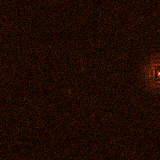
- GCN NOTICE
TITLE: GCN/SWIFT NOTICE
NOTICE_DATE: Sun 22 Apr 12 07:26:48 UT
NOTICE_TYPE: Swift-UVOT Processed Image
TRIGGER_NUM: 520658, Seg_Num: 0
POINT_RA: 136.949d {+09h 07m 48s} (J2000)
POINT_DEC: +14.009d {+14d 00' 32"} (J2000)
ROLL: 286.398d
IMG_START_DATE: 16039 TJD; 113 DOY; 12/04/22
IMG_START_TIME: 26185.98 SOD {07:16:25.98} UT, 262.3 [sec] since BAT Trigger Time
FILTER: 7, U
EXPOSURE_ID: 356771794
X_OFFSET: 1026 [pixels]
Y_OFFSET: 740 [pixels]
WIDTH: 160 [pixels]
HEIGHT: 160 [pixels]
X_GRB_POS: 1186
Y_GRB_POS: 900
BINNING_INDEX: 1
IM_URL: sw00520658000msuni0271.fits
SUN_POSTN: 30.38d {+02h 01m 30s} +12.36d {+12d 21' 51"}
SUN_DIST: 102.79 [deg] Sun_angle= -7.1 [hr] (East of Sun)
MOON_POSTN: 40.34d {+02h 41m 22s} +17.67d {+17d 39' 59"}
MOON_DIST: 92.06 [deg]
MOON_ILLUM: 1 [%]
GAL_COORDS: 215.25, 36.47 [deg] galactic lon,lat of the pointing direction
ECL_COORDS: 135.20, -2.37 [deg] ecliptic lon,lat of the pointing direction
COMMENTS: SWIFT-UVOT Processed Image.
COMMENTS: The GRB Position came from the XRT Position Command.
COMMENTS: The image has 2x2 binning (compression).
COMMENTS: All 4 attachments are included.
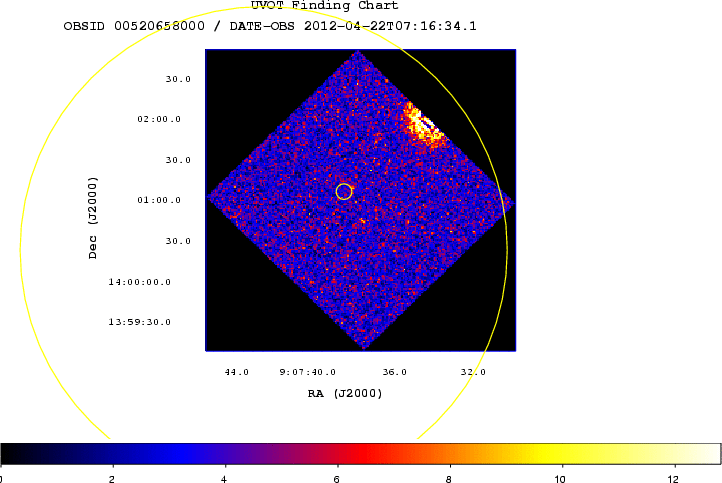
- GCN NOTICE
TITLE: GCN/SWIFT NOTICE
NOTICE_DATE: Sun 22 Apr 12 07:26:17 UT
NOTICE_TYPE: Swift-XRT Position UPDATE
TRIGGER_NUM: 520658, Seg_Num: 0
GRB_RA: 136.9096d {+09h 07m 38.30s} (J2000),
137.0789d {+09h 08m 18.94s} (current),
136.2209d {+09h 04m 53.02s} (1950)
GRB_DEC: +14.0184d {+14d 01' 06.2"} (J2000),
+13.9683d {+13d 58' 05.8"} (current),
+14.2206d {+14d 13' 14.0"} (1950)
GRB_ERROR: 2.9 [arcsec radius, statistical plus systematic, 90% containment]
GRB_INTEN: 1.00e-10 [erg/cm2/sec]
GRB_SIGNIF: 10.00 [sigma]
IMG_START_DATE: 16039 TJD; 113 DOY; 12/04/22
IMG_START_TIME: 26104.00 SOD {07:15:04.00} UT, 180.4 [sec] since BAT Trigger Time
TAM[0-3]: 100.00 100.00 100.00 100.00
AMPLIFIER: 1
WAVEFORM: 31
SUN_POSTN: 30.37d {+02h 01m 30s} +12.36d {+12d 21' 51"}
SUN_DIST: 102.75 [deg] Sun_angle= -7.1 [hr] (East of Sun)
MOON_POSTN: 40.34d {+02h 41m 20s} +17.67d {+17d 39' 56"}
MOON_DIST: 92.02 [deg]
MOON_ILLUM: 1 [%]
GAL_COORDS: 215.22, 36.44 [deg] galactic lon,lat of the burst
ECL_COORDS: 135.16, -2.37 [deg] ecliptic lon,lat of the burst
COMMENTS: SWIFT-XRT Coordinates.
COMMENTS: This Notice was ground-generated -- not flight-generated.
COMMENTS: This is an Update Notice -- the RA,Dec values herein supersede the previous XRT_POS Notice.
COMMENTS: TAM values, flux and significance fields are not valid.
COMMENTS: This position was automatically generated on the ground using
COMMENTS: Photon Counting data telemetered via TDRSS (SPER data).
COMMENTS: See http://www.swift.ac.uk/sper/docs.php for details.
COMMENTS: This position was enhanced using UVOT field astrometry.
COMMENTS: The probability that this is a serendipitous source in the
COMMENTS: SPER window is 0.11% < P(seren) < 0.58%.
- GCN NOTICE
TITLE: GCN/SWIFT NOTICE
NOTICE_DATE: Sun 22 Apr 12 07:33:13 UT
NOTICE_TYPE: Swift-UVOT Source List
TRIGGER_NUM: 520658, Seg_Num: 0
POINT_RA: 136.949d {+09h 07m 48s} (J2000)
POINT_DEC: +14.009d {+14d 00' 32"} (J2000)
POINT_ROLL: 286.399d
IMG_START_DATE: 16039 TJD; 113 DOY; 12/04/22
IMG_START_TIME: 26781.13 SOD {07:26:21.13} UT, 857.5 [sec] since BAT Trigger Time
FILTER: 10, White
BKG_MEAN: 3.072
N_STARS: 190
X_OFFSET: 466 [pixels]
Y_OFFSET: 180 [pixels]
X_MAX: 1905 [pixels]
Y_MAX: 1619 [pixels]
DET_THRESH: 14
PHOTO_THRESH: 8
SL_URL: sw00520658000msufc0857.fits
SUN_POSTN: 30.38d {+02h 01m 31s} +12.37d {+12d 21' 57"}
SUN_DIST: 102.79 [deg] Sun_angle= -7.1 [hr] (East of Sun)
MOON_POSTN: 40.39d {+02h 41m 35s} +17.68d {+17d 40' 41"}
MOON_DIST: 92.01 [deg]
MOON_ILLUM: 1 [%]
GAL_COORDS: 215.25, 36.47 [deg] galactic lon,lat of the pointing direction
ECL_COORDS: 135.20, -2.37 [deg] ecliptic lon,lat of the pointing direction
COMMENTS: SWIFT-UVOT Source List.
- GCN NOTICE
TITLE: GCN/SWIFT NOTICE
NOTICE_DATE: Sun 22 Apr 12 07:33:31 UT
NOTICE_TYPE: Swift-UVOT Processed Source List
TRIGGER_NUM: 520658, Seg_Num: 0
POINT_RA: 136.949d {+09h 07m 48s} (J2000)
POINT_DEC: +14.009d {+14d 00' 32"} (J2000)
POINT_ROLL: 286.399d
IMG_START_DATE: 16039 TJD; 113 DOY; 12/04/22
IMG_START_TIME: 26781.13 SOD {07:26:21.13} UT, 857.5 [sec] since BAT Trigger Time
FILTER: 10, White
BKG_MEAN: 3.072
N_STARS: 190
X_OFFSET: 466 [pixels]
Y_OFFSET: 180 [pixels]
X_MAX: 1905 [pixels]
Y_MAX: 1619 [pixels]
DET_THRESH: 14
PHOTO_THRESH: 8
SL_URL: sw00520658000msufc0857.fits
SUN_POSTN: 30.38d {+02h 01m 31s} +12.37d {+12d 21' 57"}
SUN_DIST: 102.79 [deg] Sun_angle= -7.1 [hr] (East of Sun)
MOON_POSTN: 40.40d {+02h 41m 35s} +17.68d {+17d 40' 43"}
MOON_DIST: 92.00 [deg]
MOON_ILLUM: 1 [%]
GAL_COORDS: 215.25, 36.47 [deg] galactic lon,lat of the pointing direction
ECL_COORDS: 135.20, -2.37 [deg] ecliptic lon,lat of the pointing direction
COMMENTS: SWIFT-UVOT Processed Source List.
COMMENTS: All 4 attachments are included.
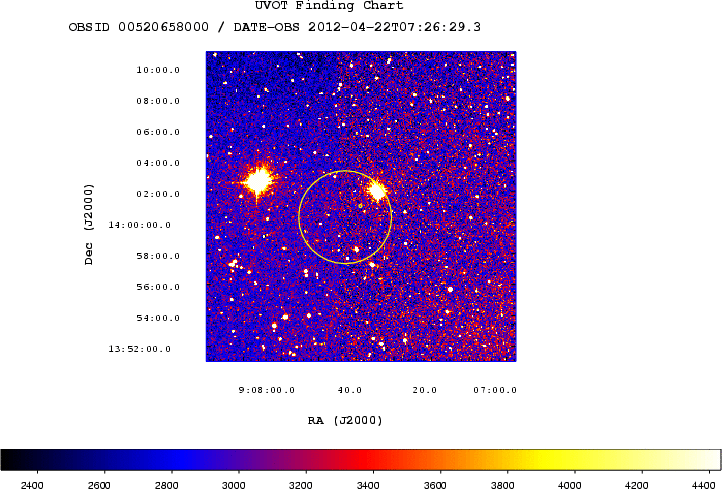
- GCN NOTICE
TITLE: GCN/SWIFT NOTICE
NOTICE_DATE: Sun 22 Apr 12 07:34:41 UT
NOTICE_TYPE: Swift-UVOT Image
TRIGGER_NUM: 520658, Seg_Num: 0
POINT_RA: 136.949d {+09h 07m 48s} (J2000)
POINT_DEC: +14.009d {+14d 00' 32"} (J2000)
ROLL: 286.399d
IMG_START_DATE: 16039 TJD; 113 DOY; 12/04/22
IMG_START_TIME: 26781.13 SOD {07:26:21.13} UT, 857.5 [sec] since BAT Trigger Time
FILTER: 10, White
EXPOSURE_ID: 356772389
X_OFFSET: 1025 [pixels]
Y_OFFSET: 739 [pixels]
WIDTH: 160 [pixels]
HEIGHT: 160 [pixels]
X_GRB_POS: 1185
Y_GRB_POS: 899
BINNING_INDEX: 1
IM_URL: sw00520658000msuni0866.fits
SUN_POSTN: 30.38d {+02h 01m 31s} +12.37d {+12d 21' 58"}
SUN_DIST: 102.79 [deg] Sun_angle= -7.1 [hr] (East of Sun)
MOON_POSTN: 40.41d {+02h 41m 37s} +17.68d {+17d 40' 51"}
MOON_DIST: 91.99 [deg]
MOON_ILLUM: 1 [%]
GAL_COORDS: 215.25, 36.47 [deg] galactic lon,lat of the pointing direction
ECL_COORDS: 135.20, -2.37 [deg] ecliptic lon,lat of the pointing direction
COMMENTS: SWIFT-UVOT Image.
COMMENTS: The GRB Position came from the Window Position in the Mode Command.
COMMENTS: The image has 2x2 binning (compression).
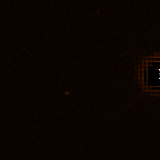
- GCN NOTICE
TITLE: GCN/SWIFT NOTICE
NOTICE_DATE: Sun 22 Apr 12 07:34:55 UT
NOTICE_TYPE: Swift-UVOT Processed Image
TRIGGER_NUM: 520658, Seg_Num: 0
POINT_RA: 136.949d {+09h 07m 48s} (J2000)
POINT_DEC: +14.009d {+14d 00' 32"} (J2000)
ROLL: 286.399d
IMG_START_DATE: 16039 TJD; 113 DOY; 12/04/22
IMG_START_TIME: 26781.13 SOD {07:26:21.13} UT, 857.5 [sec] since BAT Trigger Time
FILTER: 10, White
EXPOSURE_ID: 356772389
X_OFFSET: 1025 [pixels]
Y_OFFSET: 739 [pixels]
WIDTH: 160 [pixels]
HEIGHT: 160 [pixels]
X_GRB_POS: 1185
Y_GRB_POS: 899
BINNING_INDEX: 1
IM_URL: sw00520658000msuni0866.fits
SUN_POSTN: 30.38d {+02h 01m 31s} +12.37d {+12d 21' 58"}
SUN_DIST: 102.79 [deg] Sun_angle= -7.1 [hr] (East of Sun)
MOON_POSTN: 40.41d {+02h 41m 38s} +17.68d {+17d 40' 52"}
MOON_DIST: 91.99 [deg]
MOON_ILLUM: 1 [%]
GAL_COORDS: 215.25, 36.47 [deg] galactic lon,lat of the pointing direction
ECL_COORDS: 135.20, -2.37 [deg] ecliptic lon,lat of the pointing direction
COMMENTS: SWIFT-UVOT Processed Image.
COMMENTS: The GRB Position came from the Window Position in the Mode Command.
COMMENTS: The image has 2x2 binning (compression).
COMMENTS: All 4 attachments are included.
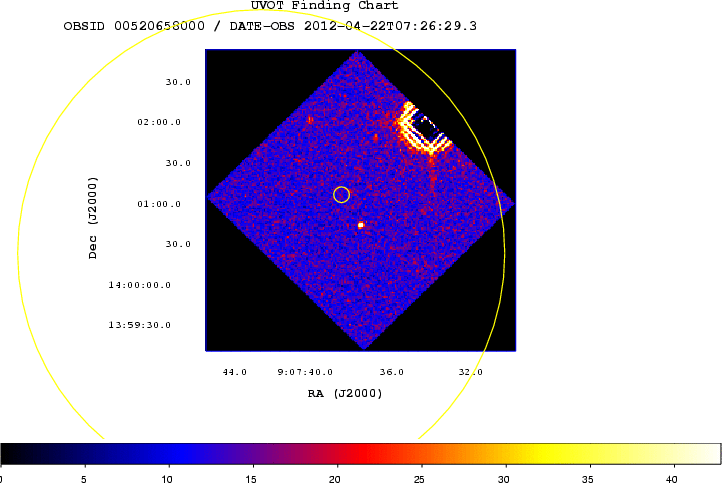
- GCN Circular #13244
C. Guidorzi (U. Ferrara), J. Japelj (U. Ljubljana),
A. Melandri (INAF-OAB) on behalf of a larger collaboration report:
"The 2-m Faulkes Telescope North robotically followed up GRB 120422A
(D'Elia et al., GCN Circ. 13243) at 07:18:38 UT, corresponding to 6.6
min after the GRB trigger time.
In the XRT error circle, in a 3x10s frame we do not find
any source brighter than R=18.4 mag, calibrated against nearby
USNOB-1 field stars.
- GCN Circular #13245
A. Cucchiara (UCSC/UCO Lick), A. Levan (U Warwick), D. B. Fox (PennState),
N. R. Tanvir (U. Leicester) report on behalf of a larger collaboration reports:
On April 22.33 UT (~50 minutes after the BAT trigger) we observed the field
of GRB 120422A (Troja et al., GCN 13243) using GMOS Spectrograph on
the Gemini-North 8-m telescope.
In our acquisition image of 240s in i' band an optical candidate was identified at:
RA: 09:07:38.38
Dec: +14:01:07.5
with an uncertainty of 0.3" in each direction.
Using three SDSS stars in the field we estimate a magnitude of
i'=19.03 +- 0.15
We also noticed just outside the XRT error circle the presence of
the SDSS (DR8) galaxy SDSS J090738.51+140108.3.
A subsequent spectrum of 2x900s, covering the wavelength range 6000-10000
does not present evident absorption features.
If the SDSS galaxy is associated with GRB 120422A then its brightness would
suggest a moderately low redshift (z<1).
Further analysis is in progress.
We thank the Gemini-North staff for their prompt support.
- GCN Circular #13246
S. D. Barthelmy (GSFC), W. H. Baumgartner (GSFC/UMBC), J. R. Cummings (GSFC/UMBC),
E. E. Fenimore (LANL), N. Gehrels (GSFC), H. A. Krimm (GSFC/USRA),
C. B. Markwardt (GSFC), D. M. Palmer (LANL), T. Sakamoto (GSFC/UMBC),
G. Sato (ISAS), M. Stamatikos (OSU), E. Troja (NASA/GSFC/ORAU),
J. Tueller (GSFC), T. N. Ukwatta (MSU)
(i.e. the Swift-BAT team):
Using the data set from T-61 to T+224 sec from recent telemetry downlinks,
we report further analysis of BAT GRB 120422A (trigger #520658)
(Troja, et al., GCN Circ. 13243). The BAT ground-calculated position is
RA, Dec = 136.915, 13.974 deg, which is
RA(J2000) = 09h 07m 39.7s
Dec(J2000) = +13d 58' 27.1"
with an uncertainty of 2.0 arcmin, (radius, sys+stat, 90% containment).
The partial coding was 68%.
The mask-weighted light curve shows a single peak starting at ~T-3 sec,
peaking at ~T+1, and ending at ~T+20 sec. There is a low-significance peak
(~3 sigma) at T+45 to T+65. T90 (15-350 keV) is 5.35 +- 1.4 sec
(estimated error including systematics).
The time-averaged spectrum from T-0.80 to T+6.00 sec is best fit by a simple
power-law model. The power law index of the time-averaged spectrum is
1.19 +- 0.24. The fluence in the 15-150 keV band is 2.3 +- 0.4 x 10^-7 erg/cm2.
The 1-sec peak photon flux measured from T+0.86 sec in the 15-150 keV band
is 0.6 +- 0.2 ph/cm2/sec. All the quoted errors are at the 90% confidence
level.
The results of the batgrbproduct analysis are available at
http://gcn.gsfc.nasa.gov/notices_s/520658/BA/
- GCN Circular #13247
A.P. Beardmore, P.A. Evans, M.R. Goad and J.P. Osborne (U. Leicester)
report on behalf of the Swift-XRT team.
Using 1079 s of XRT Photon Counting mode data and 2 UVOT
images for GRB 120422A, we find an astrometrically corrected X-ray
position (using the XRT-UVOT alignment and matching UVOT field sources
to the USNO-B1 catalogue): RA, Dec = 136.91027, +14.01822 which is equivalent
to:
RA (J2000): 09h 07m 38.46s
Dec (J2000): +14d 01' 05.6"
with an uncertainty of 1.9 arcsec (radius, 90% confidence).
This position may be improved as more data are received. The latest
position can be viewed at http://www.swift.ac.uk/xrt_positions. Position
enhancement is described by Goad et al. (2007, A&A, 476, 1401) and Evans
et al. (2009, MNRAS, 397, 1177).
This circular was automatically generated, and is an official product of the
Swift-XRT team.
- GCN Circular #13248
N. P. M. Kuin (MSSL-UCL) and E. Troja (NASA/GSFC/ORAU) report on
behalf of the Swift/UVOT team:
The Swift/UVOT began settled observations of the field of GRB 120422A
104 s after the BAT trigger (Troja et al., GCN Circ. 13243). A source
consistent with the XRT position (Beardmore et al., GCN Circ. 13247)
is detected in the summed UVOT exposures at position:
RA (J2000) = 136.91012 deg. = 09:07:38.4
Dec (J2000) = +14.018782 deg. = +14:01:07.6
with an estimated uncertainty of 1".
Preliminary detections and 3-sigma upper limits using the UVOT photometric
system (Breeveld et al. 2011, AIP Conf. Proc. 1358, 373) for the early
exposures are:
Filter T_start(s) T_stop(s) Exp(s) Mag
white_FC 104 254 147 20.39 +/- 0.27
white 857 1007 147 20.51 +/- 0.29
white 5251 6888 393 20.25 +/- 0.15
v 5662 5862 1082 >19.4
b 5047 6683 393 >20.7
u 262 512 246 19.89 +/- 0.32
u 4842 6478 393 20.00 +/- 0.31
w1 4637 12807 1039 19.84 +/- 0.18
m2 5867 6067 197 19.21 +/- 0.28
m2 11245 12145 886 19.36 +/- 0.14
w2 5457 7032 332 18.98 +/- 0.16
The magnitudes in the table are not corrected for the Galactic extinction
due to the reddening of E(B-V) = 0.03 in the direction of the burst
(Schlegel et al. 1998).
- GCN Circular #13249
B. Sbarufatti (INAF-OAB/PSU), G. Stratta (ASDC), P. D'Avanzo
(INAF-OAB), J.A. Kennea (PSU), M.C. Stroh (PSU), D.N. Burrows (PSU),
J.P. Osborne (U. Leicester), K.L. Page (U. Leicester), C. Pagani (U.
Leicester) and E. Troja report on behalf of the Swift-XRT team:
We have analysed 13 ks of XRT data for GRB 120422A (Troja et al. GCN
Circ. 13243), from 101 s to 30.1 ks after the BAT trigger. The data
comprise 307 s in Windowed Timing (WT) mode with the remainder in
Photon Counting (PC) mode. The enhanced XRT position for this burst was
given by Beardmore et al. (GCN. Circ 13247).
The light curve can be modelled with an initial power-law decay with an
index of alpha=6.22 (+0.30, -0.28), followed by a break at T+373 s to
an alpha of 0.30 (+0.11, -0.14).
A spectrum formed from the WT mode data can be fitted with an absorbed
power-law with a photon spectral index of 4.5 (+0.4, -0.3). The
best-fitting absorption column is 2.5 (+0.5, -0.4) x 10^21 cm^-2, in
excess of the Galactic value of 3.7 x 10^20 cm^-2 (Kalberla et al.
2005). The counts to observed (unabsorbed) 0.3-10 keV flux conversion
factor deduced from this spectrum is 1.9 x 10^-11 (1.7 x 10^-10) erg
cm^-2 count^-1.
A summary of the WT-mode spectrum is thus:
Total column: 2.5 (+0.5, -0.4) x 10^21 cm^-2
Galactic foreground: 3.7 x 10^20 cm^-2
Excess significance: 8.5 sigma
Photon index: 4.5 (+0.4, -0.3)
The results of the XRT-team automatic analysis are available at
http://www.swift.ac.uk/xrt_products/00520658.
This circular is an official product of the Swift-XRT team.
- GCN Circular #13250
A. Klotz (IRAP-CNRS-OMP), D. Macpherson (UWA/ICRAR), D. Coward (UWA),
B. Gendre (ASDC/INAF-OAR), M. Boer (UNS-CNRS-OCA),
A. Williams (PO-UWA), R. Martin (PO-UWA) report:
We imaged the field of GRB 120422A detected by SWIFT
(trigger 520658) with the Zadko robotic telescope (D=100cm)
located at the observatory - Gingin, Australia.
The observations started 3.6h and finished 4.8h
after the GRB trigger.
Weather conditions were good but a poor seeing
of 3.5 arcsec does not allow to separate the
GRB afterglow (Cucchiara et al. GCNC 13245) and
the SDSS galaxy J090738.51+140108.3.
We added the r, g, i SDSS images to create an
equivalent of the Zadko unfiltered image.
The star R=16.37 at ra=136.9080750 dec=+14.0119528
J2000 was used as reference. The flux ratio
of the reference star and the galaxy shows that an
additional component at R=21.1 should be present
in the galaxy on the Zadko image.
start end Rmag dmag filter
(h) (h)
3.6 4.8 21.1 0.2 CR
- GCN Circular #13251
N. R. Tanvir (U. Leicester), A. J. Levan (U. Warwick), A. Cucchiara (UCSC/UCO Lick) &
D. B. Fox (Penn State) report on behalf of a larger collaboration:
Further analysis of the Gemini/GMOS spectrum of the nearby galaxy reported by
Cucchiara et al. (GCN 13245) revealed emission lines of Ha, OIII(5007/4959) and Hb
at a common redshift of z=0.28. At this redshift, the impact parameter of the afterglow
is about 8kpc, which would be a rather large offset for a long-GRB, but certainly possible.
If the galaxy is the host, then the absence of absorption lines in the afterglow spectrum
would not be too surprising, given the weakness of expected lines in the observed
wavelength range. However, it would also make it one of the lowest
redshift GRBs so far detected by Swift, and so an important target for further follow-up.
- GCN Circular #13252
S. Schulze (U. Iceland), D. Malesani (DARK/NBI), A. de Ugarte Postigo
(IAA-CSIC, DARK/NBI), A. J. Levan (U Warwick), P. Jakobsson (U.
Iceland), E. Wuyts (KIPAC Chicago) report on behalf of a larger
collaboration:
We observed the field of GRB 120422A (Troja et al., GCN 13243) with
the Nordic Opitcal Telescope (NOT) equipped with MOSCA. We obtained 12
x 300 s I-band images. Observations started at 20:54 UT on April 22
(i.e., 13.3 hrs after the burst).
We clearly detected the source reported in Cucchiara et al. (GCN
13245) in all individual images. There was no significant fading
during observations. The source has an I-band brightness of 21.7 mag
(Vega magnitude) in the stacked image. This value is not corrected for
foreground extinction and calibrated with the #1039-0167772 star (I =
18.98 mag) in the USNO B1 catalogue.
- GCN Circular #13253
L. P. Xin, J. Y. Wei, Y. L. Qiu, J. Wang, J. S. Deng,
C. Wu, X. H. Han on behalf of EAFON report:
We began to observe GRB 120422A (Troja et al., GCN 13243)
with Xinglong TNT telescope in R-band at 11:37:41(UT),
4.45 hours after the burst under the bad weather condition.
The optical counterpart ( Cucchiara et al. GCN 13245;
Kuin et al. GCN 13248; Klotz et al. GCN 13250; Schulze et al. GCN 13252)
was not detected in our combined image.
The upper limit was estimated about 19.5 mag in R band
at the mean time of 5.15 hours after
the burst, calibrated against the USNO B1.0 R2mag.
This message may be cited.
For more information about Xinglong GRBs Follow-up
observations, please visit the website:
http://www.xinglong-naoc.org:8080/grb/index.html
We thank Liang Ma for performing these observations.
- GCN Circular #13254
Ashley Zauderer, Edo Berger and Tanmoy Laskar (Harvard) report:
"We observed the position of GRB 120422A (GCN 13243) with the EVLA at 6
GHz and 22 GHz beginning 2012 Apr 23.09 (0.8 d after the burst). We
detect a 5- and 3-sigma source (for 6 and 22 GHz, respectively)
consistent with the Swift-XRT position (GCN 13247) and the UVOT position
(GCN 13248). The position of the radio source is
RA 09:07:38.42 (+/- 0.01)
DEC +14:01:07.1 (+/- 0.2)
Followup observations are planned."
- GCN Circular #13255
Adria C. Updike (Dickinson College), Dieter H. Hartmann (Clemson
University), Peter A. Milne (Steward Observatory), and G. Grant Williams
(MMTO) report:
We observed the field of GRB 120422A (Troja et al., GCN 13243) with the
0.6m Super-LOTIS telescope at KPNO beginning 77 seconds after the
trigger under good conditions. We do not detect the OT (Cucchiara et
al., GCN 13245; Kuin & Troja, GCN 13248) in the R band. Limiting
magnitudes are given below, compared to the USNO B1.0 catalog.
midtime (s) stack limiting mag
----------------------------------------------------
126 4 x 5s 16.4
233 5 x 10s 16.9
557 5 x 60s 19.0
- GCN Circular #13256
M. Nardini (Uni. Milano-Bicocca), S. Schmidl (TLS Tautenburg),
J. Greiner (MPE Garching), and D.A. Kann (TLS Tautenburg) report on behalf of the GROND team:
We observed the field of GRB 120422A (Swift trigger 520658, Troja et al.,
GCN #13243) simultaneously in g'r'i'z'JHK with GROND (Greiner et al. 2008,
PASP 120, 405) mounted at the 2.2 m MPI/ESO telescope at La Silla
Observatory (Chile).
Observations started on April 22, 2012, at 23:39 UT, 16.5 hr after the GRB
trigger, and continued for 3 hours. They were performed at an average seeing of
1.45" and at an average airmass of 1.45.
Based on 49 min of total exposures in g'r'i'z' and 100 min in JHK
we found a blue source consistent with the afterglow position
reported by Kuin et al. (GCN #13248) and Cucchiara et al. (GCN #13245).
In g'r'i'z'J we measure a separation of about 1.6" from the SDSS (DR8) galaxy
SDSS J090738.51+140108.3 cited by Cucchiara et al., even if we notice that this value is just slightly larger than the measured seeing.
At the position of afterglow candidate we measure the following magnitudes (in the AB system)
g' = 21.68 +- 0.05 AB mag,
r' = 21.59 +- 0.05 AB mag,
i' = 21.3 +- 0.1 AB mag
calibrated against SDSS field stars and not corrected for Galactic foreground reddening of E(B-V)=0.035 (Schlegel et al. 1998).
We note that the i'-band measurement is significantly contaminated by the underlying candidate host galaxy and thus has to be considered preliminary. Nonetheless, a comparison with the earlier observations reported by Cucchiara et al. (GCN #13245) indicate a fading of at least 2 mag and thus confirms the afterglow nature of the source.
- GCN Circular #13257
S. Schulze (Univ. Iceland), A. J. Levan (Univ. Warwick), D. Malesani
(DARK/NBI), J. P. U. Fynbo (DARK/NBI), N. R. Tanvir (Univ. Leicester),
B. Milvang-Jensen (DARK/NBI), A. de Ugarte Postigo (IAA/CSIC and
DARK/NBI), V. D'Elia (ASI/ASDC and INAF/OAR), J. Sollerman (OKC,
Stockholm), J. Hjorth (DARK/NBI), report on behalf of the X-shooter GRB
GTO collaboration:
We observed the optical counterpart of GRB 120422A (Troja et al., GCN
13243; Cucchiara et al., GCN 13245) with the ESO VLT equipped with the
X-shooter spectrograph. Observations started on 2012 April 22.99 UT
(16.5 hr after the GRB), for a total exposure time of 80 min in each of
the UVB, VIS, and NIR arms, covering the wavelength range 3000-25000 AA.
The slit was aligned so to cover both the galaxy at z = 0.28 present in
the SDSS (Cucchiara et al., GCN 13245; Tanvir et al., GCN 13251) and the
GRB optical counterpart (Cucchiara et al., GCN 13245).
We detect a plethora of nebular emission lines from the candidate host
galaxy, including [O II], [O III], Balmer lines up to Hzeta, [N II], [S
II], at a common redshift z = 0.283, thus confirming the results of
Tanvir et al. (GCN 13251).
The trace of the GRB counterpart is rather blue (see also Nardini et
al., GCN 13256), and we detect Mg II at z = 0.283 in absorption. No
further absorption features are visible. We also note that the spatial
extent of the brightest emission lines from the SDSS galaxy encompasses
the position of the GRB counterpart, indicating nebular emission at z =
0.283 at the GRB position.
While a chance superposition cannot be excluded, we note that the lack
of absorption features at z > 0.283 would require a very tenuous
environment at the GRB location. Furthermore, the UVOT detection in all
the UV filters (Kuin & Troja, GCN 13248) implies a low redshift z <~
1.3. Last, we note that the UVOT photometry at t ~ 5 ks after the burst
reveals a very blue spectrum, which is not typical of GRB afterglows,
but is reminiscent of the very blue early emission of GRB 060218
(Campana et al. 2006, Nature, 442, 1008). We thus conclude that the GRB
is also likely at z = 0.283.
Using the gamma-ray fluence reported by Barthelmy et al. (GCN 13246), at
z = 0.283 the isotropic-equivalent energy release of GRB 120422A is
~4.4*10^49 erg, which is typical of local GRBs, often associated with
supernovae. We encourage photometric and spectroscopic follow-up to
detect the emergence of a supernova, or lack thereof.
We acknowledge the excellent support of the ESO observing staff in
Paranal, in particular Henri Boffin and Giovanni Carraro. We thank Nino
Cucchiara for providing us with a finding chart from the Gemini
observation (GCN 13245).
- GCN Circular #13258
J. Wren, W.T. Vestrand, P. Wozniak, and H. Davis,
of Los Alamos National Laboratory report:
The RAPTOR network of robotic optical telescopes made observations of Swift
trigger 520658 (Troja et al., GCN 13243). The burst location was within
the field of our wide-field monitor located in Maui, HI, which began a 10 s
integration of the location at 07:12:06.81 UT, 3.2 s after the Swift trigger
time and during the gamma-ray emitting interval. The optical counterpart
(Cucchiara, et al., GCN 13245, and Kuin et al., GCN 13248) was not detected
above our 3-sigma limiting magnitude of 10.3 based on a comparison of our
unfiltered image to the Tycho-2 V-band catalog. Our narrow-field instruments
in Los Alamos, NM, began imaging at 07:12:55.49 UT, 51.8 s after the Swift
trigger and 5.7 s after receiving the GCN packet. The initial 5 s exposure
shows no counterpart to a 3-sigma limiting magnitude of 16.6 when compared
to the USNO-B1 R-band. The following table gives a sample of our
observations. The start time is given as the seconds between the start of
the exposure and the initial Swift trigger time.
start(s) exp(s) mag limit
--------------------------------
-16.8 10.0 >10.3
3.2 10.0 >10.3
22.7 10.0 >10.3
51.8 5.0 >16.6
60.8 5.0 >16.9
149.8 10.0 >17.4
437.2 30.0 >17.9
- GCN Circular #13259
I.A. Smith (Rice U.), R.P.J. Tilanus (JAC), N.R. Tanvir (U. of Leicester),
D.A. Frail (NRAO) report:
We observed the counterpart to GRB 120422A (Troja et al., GCN Circ.
13243) using the SCUBA-2 sub-millimeter continuum camera on the James
Clerk Maxwell Telescope. The observation started at 07:53 UT on
2012-04-22, corresponding to 41 minutes after the burst trigger.
Exposures totaling 1.5 hours were made in moderate weather conditions.
No source was detected, with a preliminary RMS of 2.8 mJy at 850 microns.
We thank William Montgomerie for his prompt support of these observations.
- GCN Circular #13260
S. Mart=EDn (ESO), G. Petitpas (SMA), A. de Ugarte Postigo (IAA-CSIC,
DARK/NBI) on behalf of a larger collaboration report:
We have observed the field of GRB 120422A (Troja et al. GCN 13243) with the Submillimeter Array (SMA, Hawaii, U.S.A.). Observations, with mean epoch
23.19 April 2012 (21.4 hours after the burst), were carried out with
8 antennas in very extended configuration at an average frequency of 272
GHz under excellent weather conditions (optical depth at 225 GHz ~0.03,
equivalent to PWV~0.5mm). The short 57 minutes integration on source yield
ed a preliminary r.m.s. of 1.2 mJy. No source is detected at the position
of the optical (Cucchiara et al. GCN 13245) and radio (Zauderer et al.
GCN 13245) afterglow down to a 3-sigma limit of 3.6 mJy.
Considering the low redshift of 0.283 (Schulze et al. GCN 13257), this limit
places GRB 120422A at the faint end of the luminosity distribution of
mm/submm GRB afterglows (see Fig. 8 of de Ugarte Postigo et al. 2012,
A&A 538, 44), consistent with what has been seen for other local
low-luminosity GRB/SN.
We acknowledge the excellent support of the SMA staff.
- GCN Circular #13263
D. Kuroda (OAO, NAOJ), H. Hanayama, T. Miyaji, J. Watanabe (IAO, NAOJ),
K. Yanagisawa (OAO, NAOJ), S.Nagayama (NAOJ), M. Yoshida (Hiroshima),
K. Ohta (Kyoto) and N. Kawai(Tokyo Tech)
report on behalf of the MITSuME collaboration:
We observed the field of GRB 120422A (Troja et al., GCNC 13243)
with the optical three color (g', Rc and Ic) CCD camera attached
to the Murikabushi 1m telescope of Ishigakijima Astronomical
Observatory.
The observation started on 2012-04-22 13:03:25 UT (~5.9 h after the
burst). We could not detect the previously reported afterglow
(Cucchiara et al., GCNC 13245) in all the three bands.
Three sigma upper limits of the OT are listed below. We used SDSS catalog
for flux calibration.
#T0+[day] MID-UT T-EXP[sec] g' Rc Ic
----------------------------------------------------------------------
0.27008 13:40:57 2880.0 >21.5 >21.3 >19.5
----------------------------------------------------------------------
T0+ : Elapsed time after the burst [day]
T-EXP: Total Exposure time [sec]
- GCN Circular #13267
FROM: Daniel Perley at Caltech
D. A. Perley (Caltech), A. Cucchiara (UCO/Lick), S. B. Cenko (UC
Berkeley), A. J. Levan (Warwick), S. R. Kulkarni, S. Ben-Ami, and Y. Cao
(Caltech) report:
We conducted a second epoch of imaging at the position of GRB 120422A
(Troja et al., GCN 13243) with GMOS-N on Gemini-North starting at 05:42
UT on 2012-04-26 in each of the griz filters. Seeing conditions were
excellent (0.7"), cleanly resolving the transient previously identified
by Cucchiara et al. (GCN 12345) from its putative host galaxy. A curved
bridge of emission connects the transient with the host, suggesting it
occurred either in a spiral arm (however no counter-arm is visible on
the far side of the galaxy) or within an interacting companion. An
image is posted to:
http://www.astro.caltech.edu/~dperley/gcn/120422a/120422a_gmos.png
The transient has clearly faded since the last observations, and is now
at r = 22.05 +/- 0.09 mag, i = 22.31 +/- 0.07 mag (using a 0.7" radius
aperture and calibrating relative to SDSS standards, with the
uncertainties due almost entirely to the systematics of the color
comparison). This would indicate a relatively blue color. However, the
(nearly contemporaneous) g-band flux lies approximately 1 magnitude
below a simple extrapolation of the r-i color, indicating that the SED
peaks in or near the r-band range.
As previously noted by Schulze et al. (GCN 13257) on the basis of the
blue UVOT color, this type of SED is very unusual for traditional GRB
afterglows (which normally are power-laws in the optical band) but
similar properties have been seen at early times in GRBs 060218 (e.g.
Campana et al., Nature 442:1008), as well as GRBs 100316D (Starling et
al. 2011, MNRAS 411:2792), and 101225 (Th=F6ne et al. 2011, Nature
480:72). We suggest that the apparent color evolution of the peak
wavelength of the transient from the UV to the optical and NIR is likely
to continue in subsequent days, and encourage multi-band photometric
follow-up as well as spectroscopy.
Additionally, on the night of 2012-04-27 UT we acquired 30 minutes of
spectroscopy using LRIS on the Keck 10m telescope. A preliminary flux
calibration of the spectrum shows a similar signature as evident in the
photometry, with a pronounced, smooth peak around 6500 Angstroms. No
obvious absorption or emission features are evident except for the
narrow emission lines from the underlying host, previously mentioned by
Tanvir et al. (GCN 13251) and Schulze et al. (GCN 13257). In
particular, we do not yet recognize any broad supernova signatures.
Further observations are planned.
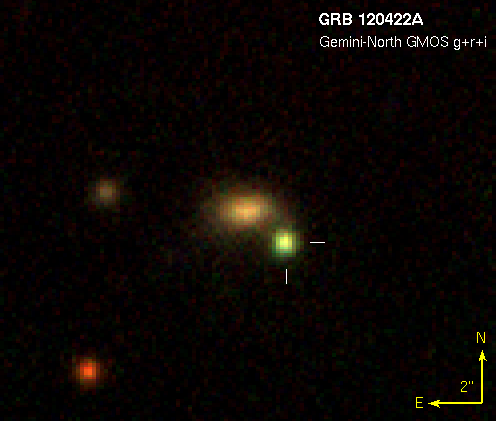
- GCN Circular #13269
We have undertaken the review of the sky area in vicinity of
GRB 120422A (A.P. Beardmore et al. GCN Circ.13247) on
astronegatives, collected in Ukrainian NAS Main astronomical
observatory plate archive (1976-1996). All the plates with
the possible object appearance are digitized using Microtek
ScanMaker 9800XL TMA and Epson Expression 10000XL flatbed
scanners and have been placed into Golosiiv Plate Archive
database DBGPA with open access to them.
The list of plates is given in the table:
YYYYMMDD/TimeUT --Plates-- Ex. LimM Star USNOA2=20
19921201/022312 GUA040C002050A 18.0 15.05 0975-06157849
19921201/025107 GUA040C002051 18.0 15.95 1575-06157752
19930114/232017 GUA040C002089A 22.5 15.05 0975-06157849
19930114/235112 GUA040C002090 22.5 15.05 0975-06157849
Plates:
GUA040C =96the plates archive identifier of DWA (D/F=3D400/2000,
M=3D103"/mm) of the Ukrainian NAS Main Astro obs.
(Marsden's number - 83) the plate number [1].
Ex. - Duration of the maximum exposure (minutes).
LimM - Limited V mag, derived in the 26 minutes area
around the location given in A.P. Beardmore et al.
GCN Circ.13247: RA(J2000): 09h 07m 38.46s,
Dec(J2000): +14d 01' 05.6"
Star USNOA2 - Comparison star.
The preview images of 4 areas together with
the 26x26 min.of arc area from SkyMap can be found in
http://gua.db.ukr-vo.org/img/grb/120422A/index.html
The images with full resolution are available via e-mail on
demand.
References:
1.L.Pakuliak DATABASE of GOLOSIIV PLATE ARCHIVE (DBGPA V2.0),
http://gua.db.ukr-vo.org
- GCN Circular #13273
V. Rumyantsev, K. Antonyuk (CrAO), A. Pozanenko (IKI) report on behalf of
larger GRB follow-up collaboration:
We observed the field of GRB 120422A (Troja et al., GCN 13243) with AZT-11
telescope of CrAO observatory on April 22 (UT) 18:54:58 - 19:55:14 under
mean seeing of 2.8 arcsec and with Shajn telescope of CrAO observatory on
April 23 (UT) 18:22:50 - 19:29:02 under mean seeing of 1.8 arcsec. In
both epochs we cannot resolve the afterglow (Cucchiara et al., GCN 13245;
Kuin et al., GCN 13248) from possible host galaxy SDSS J090738.51+140108.3
and we used aperture photometry of host + afterglow. A preliminary
photometry is based on the USNO-B1.0 star 1040-0165213 (09 07 37.94 +14 00
43.0) assuming R=16.37:
T0+ Filter, Exposure, OT+host, uplim (3 sigma)
(mid, d) (s)
0.5091 R 20x180 20.5 +/-0.3 20.8
1.4891 R 60x60 20.74 +/-0.03 23.9
From the above photometry of the host + afterglow it is evident that in both
epochs there is apparent admixture of the afterglow in the brightness of the
galaxy SDSS J090738.51+140108.3 which have a brightness of R ~ 21.0.
We are grateful for CCD PL4240 provided by ISON for Shajn telescope.
- GCN Circular #13275
D. Malesani (DARK/NBI), S. Schulze (Univ. Iceland), T. Kruehler (DARK/NBI), G. Leloudas (OKC/Stockholm and DARK/NBI), A. de Ugarte Postigo (IAA/CSIC and DARK/NBI), D. Xu (WIS), J. P. U. Fynbo, J. Hjorth (DARK/NBI), P. Jakobsson (Univ. Iceland), R. Kotak, D. Wright (Queens University Belfast), G. Barisevicius, S. Geier (NOT), report on behalf of a larger collaboration:
We have used the NOT equipped with ALFOSC to monitor the optical counterpart of GRB 120422A (Troja et al., GCN 13243; Cucchiara et al., GCN 13245).
The source brightened by 0.80 +- 0.15 mag between Apr. 25.86 UT and Apr. 30.90 UT (3.56 and 8.60 days after the GRB, respectively). On Apr. 25.86 UT the counterpart had i ~ 22.10, calibrated against stars from the SDSS catalogue. This is consistent with the measurement by Perley et al. (GCN 13267) at a similar epoch. On Apr. 30.90 UT, we measure i = 21.30 +/- 0.15.
We suggest this re-brightening to be due to the emerging supernova.
Also posted as
ATEL 4082
- GCN Circular #13276
K. Wiersema (U. Leicester), A. Cucchiara (UCSC/UCO Lick),
A. J. Levan (U. Warwick), S. Rapoport, B. P. Schmidt (ANU), D. Bersier (LJMU),
D. Perley (Caltech), S. B. Cenko (UC Berkeley), N. R. Tanvir (U. Leicester)
report on behalf of a larger collaboration:
We observed the position of GRB 120422A (Troja et al., GCN 13243) using
the GMOS-N Spectrograph on the Gemini-North telescope. We acquired spectra
starting at 06:36 UT on 1 May 2012. We used the R400 grism, obtaining 4 x 1200
seconds exposure time, covering a wavelength range 4400 - 8670 A.
In addition to many narrow nebular lines from the host galaxy (Tanvir et
al. GCN 13251; Schulze et al. GCN 13257), the spectra show several broad
undulations in the continuum. The restframe positions of these features are
well matched to those seen in spectra of SN 1998bw at early times. We
therefore conclude that the rebrightening reported by Malesani et al. (GCN
13275) is consistent with being caused by a broad-lined type Ib/c supernova.
We thank Kristin Chiboucas for obtaining these observations.
- GCN Circular #13277
D. Malesani (DARK/NBI), S. Schulze (Univ. Iceland), T. Kruehler, J. P. U.
Fynbo, J. Hjorth, B. Milvang-Jensen, D. Watson (DARK/NBI), A. de Ugarte Postigo
(IAA/CSIC and DARK/NBI), N. R. Tanvir (Univ. Leicester), G. Tagliaferri
(INAF-OAB), G. Leloudas, J. Sollerman (OKC, Stockholm), D. Xu (WIS, Israel), M.
D. Stritzinger (IFA, Aarhus), A. De Cia (Univ. Iceland) report on behalf of the
X-shooter GRB GTO collaboration:
We observed the re-brightened optical counterpart of GRB 120422A (Troja et al.,
GCN 13243; Cucchiara et al., GCN 13245; Malesani et al., GCN 13275) with the
ESO VLT equipped with the X-shooter spectrograph. Observations started on 2012
May 1.0 UT (8.7 days after the GRB), for a total exposure time of 80 min in
each of the UVB, VIS, and NIR arms, covering the wavelength range 3000-25000
A. The slit was aligned to cover both the galaxy at z = 0.28 present in
the SDSS (Cucchiara et al., GCN 13245; Tanvir et al., GCN 13251) and the
optical counterpart (Cucchiara et al., GCN 13245).
The spectrum exibits a broad emission peak centred at 6300 A similar to the
previous report based on a Keck spectrum taken on April 27 (Perley et al., GCN
13267). Blueward of the peak the spectrum drops steeply down to around 4000 A
and beyond that we do not detect flux. Over the full covered spectral range
the spectrum bears a good resemblance with spectra of SN 1998bw, associated
with GRB 980425, about 6 days before maximum (Patat et al. 2001, ApJ, 555,
900).
We acknowledge the excellent support of the ESO observing staff, in particular
Claudio Melo, Giacomo Beccari, Marcelo Lopez and Ivo Saviane. We also thank
the visiting astronomer Luca Sbordone for allowing us to observe the event.
- GCN Circular #13278
D. A. Perley (Caltech) reports on behalf of a larger collaboration:
We observed the position of GRB 120422A (Troja et al., GCN 13243) with
the Combined Array for Research in Millimeter-Wave Astronomy (CARMA) at
a frequency of 92.5 GHz (3 mm) between 23:13 on 2012-04-24 and 00:29 on
2012-04-25 (UT). The mean observation time was 2.6937 days after the GRB
trigger.
No source is detected at the position of the X-ray (GCN 13243) optical
(Cucchiara et al., GCN 13245) and radio (Zauderer et al., GCN 13254)
counterparts. The 3-sigma limit of the map is 1.15 mJy.
- GCN Circular #13279
D. A. Perley, T. Jones, and R. Ellis (Caltech) report:
We observed the field of GRB 120422A (Troja et al., GCN 13243) with the
Wide-field IR Camera (WIRC) on the Palomar 200-inch telescope between
04:01 and 05:04 UT on 2012-05-02. 15 exposures of 240s each (1 hour of
observations total) were acquired in the J-band filter.
The optical counterpart to GRB 120422A (at this stage probably a rising
supernova; GCNs 13275, 13276, 13277) is clearly detected in the combined
image. Seeing conditions were good and the transient is resolved from
its host galaxy, although the background is affected by scattered light
from the bright star 1 arcmin to the northwest. Using a 0.8 arcsec
radius aperture, we measure a magnitude of J = 20.7 +/- 0.2 at a mean
time of 9.89 days after the burst.
- GCN Circular #13281
R. Sanchez-Ramirez (IAA-CSIC), G. Leloudas (OKC, Stockholm),
A. de Ugarte Postigo (IAA-CSIC, DARK/NBI), C.C. Thoene (IAA-CSIC),
J. Gorosabel (IAA-CSIC), D. Malesani (DARK/NBI), S. Schulze (Univ. Iceland),
J. P. U. Fynbo (DARK/NBI), N. R. Tanvir (Univ. Leicester), J. Hjorth (DARK/NBI),
D. Xu (WIS) report on behalf of a larger collaboration:
We have obtained spectroscopy of the optical counterpart of GRB 120422A
(Troja et al. GCN 13243, Cucchiara et al. GCN 13245) and its host galaxy, at
a redshift of 0.283 (Tanvir et al. GCN 13251, Schulze et al. GCN 13257) in two
epochs, 3.6 and 14.6 days after the burst. Both spectra were obtained with a
resolution of ~500 and cover the range between 4800 and 10000 AA.
The first epoch is close to the minimum of the light curve, before the detection
of the SN component (Malesani et al. GCN 13275), the spectrum is blue,
flattening at ~5000 AA. It shows nebular emissions but no clear characteristic
broad features of a SN spectrum.
In the second spectrum, we clearly detect SN features, as reported by Wiersema
(GCN 13276) and Malesani (GCN 13277). These features are now prominent
and give an excellent match with those of broad-lined Ic SNe close to maximum,
using SNID (Blondin & Tonry 2007, ApJ, 666, 1024).
In our spectra we included an object located 5" East of the host galaxy, which has
emission lines at the same redshift as the host and a projected distance at
z=0.283 of 22 kpc. This could indicate the existence of an interacting system.
We acknowledge the excellent support of the GTC staff, in particular Jose Miguel
Gonzalez Perez, Daniel Reverte Paya, Antonio Cabrera Lavers and Rene Rutten.
- GCN Circular #13288
J. Kelemen (kelemen at konkoly.hu) on behalf of the GRB OT observing program
at the Konkoly Observatory.
Starting on the evening of 11/05/2012 we observed the field of GRB 120422A
(Troja et al., GCN 13243) 19.448 days after the burst, using a 50 cm
Cassegrain telescope located at the Mountain Station of the Konkoly
Observatory equipped with an Andor iXon + 888 EMCCD camera through R and I
filters. On the coadded R images (exp.time 600 sec) we could not detect the OT
associated SN (Giorgos Leloudas GCN 13275)and the nearby galaxy (SDSS
J090738.51+140108.3)(A. Cucchiara GCN 13245). Based on a nearby star
(USNO-A2.0 0975-06157109) we provide 19.07 +/- 0.26 magnitude in the R band as
an upper limit.
- 1206.0298 from 5 Jun 12
Bin-Bin Zhang et al.: GRB 120422A: A Low-luminosity Gamma-ray Burst Driven by Central Engine
GRB 120422A is a low-luminosity Gamma-ray burst (GRB) associated with a bright supernova, which distinguishes itself by its relatively short
T90 ~ 5 s and an energetic X-ray tail. We analyze the Swift BAT and XRT data and discuss the physical implications. We show that the early
steep decline in the X-ray light curve can be interpreted as the curvature tail of a late emission episode around 58-86 s, with a curved
instantaneous spectrum at the end of the emission episode. Together with the main activity in the first ~ 20 s and the weak emission from 40 s
to 60 s, the prompt emission is variable, which points towards a central engine origin, in contrast to the shock breakout origin as invoked to
interpret some other nearby low-luminosity supernova GRBs. The curvature effect interpretation and interpreting the early shallow decay as the
coasting external forward shock emission in a wind medium both give a constraint on the bulk Lorentz factor \Gamma to be around several.
Comparing the properties of GRB 120422A and other supernova GRBs, we found that the main criterion to distinguish engine-driven GRBs from the
shock breakout GRBs is the time-averaged luminosity, with a separation line of about ~ 10^{48} erg s^{-1}.
- 1206.5532 from 26 Jun 12
A. Melandri et al.: The Optical SN 2012bz Associated with the Long GRB 120422A
The association of Type Ic supernovae (SNe) with long-duration gamma-ray bursts (GRB) is well established. GRB 120422A was a low-redshift
(z=0.283) event that allowed an extensive ground-based observational campaign to monitor the light curve of the associated SN 2012bz. We
obtained a series of photometric and spectroscopic observations of SN 2012bz associated with the long-duration GRB 120422A using the 3.6-m TNG
and the 8.2-m VLT telescopes during the time interval between 4 and 36 days after the burst. We characterized the optical light curve of SN
2012bz and compared its shape with other GRB/SNe. Peak brightness was reached ~18 days after the burst, corresponding to ~14 days in the
rest-frame. A general resemblance between the spectra of SN 2012bz and SN 1998bw at similar epochs is noticed, but the spectra are too noisy
for detailed analysis. The shape and maximum of the bolometric light curve (M ~ -18.7) are very similar to those of other known GRB/SNe,
suggesting comparable explosion conditions and parameters. GRB 120422A may lie slightly above the 2\sigma confidence region of the Epeak-Eiso
relation.
- 1304.7736 from 30 Apr 13
Jens Hjorth: The supernova/gamma-ray burst/jet connection
The observed association between supernovae and gamma-ray bursts represents a cornerstone in our understanding of the nature of gamma-ray
bursts. The collapsar model provides a theoretical framework for this connection. A key element is the launch of a bi-polar jet (seen as a
gamma-ray burst). The resulting hot cocoon disrupts the star while the 56Ni produced gives rise to radioactive heating of the ejecta, seen as a
supernova. In this discussion paper I summarise the observational status of the supernova/gamma-ray burst connection in the context of the
'engine' picture of jet-driven supernovae and highlight SN 2012bz/GRB 120422A -- with its luminous supernova but intermediate high-energy
luminosity -- as a possible transition object between low-luminosity and jet gamma-ray bursts. The jet channel for supernova explosions may
provide new insight into supernova explosions in general.
- GCN Circular #18183
Xianggao Wang (UC Berkeley, GXU, UNLV), WeiKang Zheng,
Alexei V. Filippenko (UC Berkeley), and S. Bradley Cenko
(GSFC) report on behalf of the KAIT GRB team:
The 0.76-m Katzman Automatic Imaging Telescope (KAIT), located at
Lick Observatory, responded to Swift GRBs 120422A (Troja et al.,
GCN 13243), 120724A (D'Avanzo et al., GCN 13510), 120803B
(Racusin et al. GCN 13566), 120911A (Cannizzo et al., GCN 13744),
and 120923A (Yershov et al., GCN 13796) at 510 s, 202 s, 196 s, 147 s,
and 236 s after the burst, respectively. Observations were performed
with an automatic sequence in the clear (roughly R), V, and I filters,
and the exposure time was 20 s per image. We do not detect any new
sources within the XRT error circles. We estimate the following upper
limits (magnitudes) in clear-band images for each GRB calibrated to
USNO B1.0:
GRB Start-Time Coadd-Images Mid-time Upper-Limit (3 sigma)
120422A 510 s 20 s x 6 758 s 20.6
120724A 202 s 20 s x 10 647 s 20.7
120803B 196 s 20 s x 10 644 s 21.7
120911A 147 s 20 s x 6 501 s 20.9
120923A 236 s 20 s x 6 563 s 21.0
![]() Previous IAU Circulars
Previous IAU Circulars 












